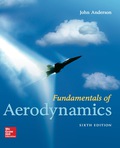
Concept explainers
The drag on the hull of a ship depends in part on the height of the water waves produced by the hull. The potential energy associated with these waves therefore depends on the acceleration of gravity g. Hence, we can state that the wave drag on the hull is
Want to see the full answer?
Check out a sample textbook solution
Chapter 1 Solutions
EBK FUNDAMENTALS OF AERODYNAMICS
Additional Engineering Textbook Solutions
Heating Ventilating and Air Conditioning: Analysis and Design
Shigley's Mechanical Engineering Design (McGraw-Hill Series in Mechanical Engineering)
Thinking Like an Engineer: An Active Learning Approach (4th Edition)
Engineering Mechanics: Statics
Automotive Technology: Principles, Diagnosis, and Service (5th Edition)
DESIGN OF MACHINERY
- A block of mass m slides along a horizontal surface lubricated with a thick oil which providesa drag force proportional to the square root of velocity.F_d=-bv^1/2If v = v0 at t = 0, determine v as a function of timearrow_forwardA sled with two runners slides along a thin horizontal layer of water between the ice and the runners. The horizontal force that the water puts on the runners is equal to 2.4 lb when the sled's speed is 50 ft/s. The total area of both runners in contact with the water is 0.04 ft2, and the viscosity of the water is 3.5x10 lbs/ft2. Determine the thickness of the water layer under the runners. Assume a linear velocity distribution in the water layer.arrow_forwardQ6) The space between two parallel plates is filled with oil. Each side of the plate is 60 cm. the thickness of oil film is 12.5 mm. The upper plate, which moves at 2.5 metre per sec requires a force of 98.1 N to maintain the Speed. Determinearrow_forward
- Determine the values of A and B such that the primary boundary conditions for the velocity profile are satisfied. Is it necessary to apply any auxiliary boundary conditions?arrow_forwardWhat happens to the buoyant force acting on the airship as it rises in the air? Does it increases or decreases? Explainarrow_forwardA plate with a length of 1.5 m is placed in a wind tunnel so that the air passes over it at a speed of 7.5 m Find the Reynolds number, then find the thickness of the layer, knowing that the kinematic viscosity is 1.679 * 10 ^ - 4arrow_forward
- Q6. Two large fixed parallel planes are 12 mm apart. The space between the surfaces is filled with oil of viscosity 0.972 N.s / m². A flat thin plate 0.25 m² area moves through the oil at a velocity of 0.3 m / s. Calculate the drag force: (1) When the plate is equidistant from both the planes, and (ii) When the thin plate is at a distance of 4 mm from one of the plane surfaces.arrow_forwardIf a stream flowing at velocity U past a body of lengthL causes a force F on the body that depends only on U , L ,and fluid viscosity μ , then F must be proportional to(a) ρUL/μ, (b) ρU2L2, (c) μU/L, (d) μUL, (e) UL/μarrow_forward2. A 0.10 cm-radius sphere falling in air (T= 20°C) at a speed of 25 m/s. Determine the following: a) Skin drag force b) Form drag force c) Total drag force. 3. The raindrops of around 3 mm diameter fallat 5 mis, while drizzle with droplets of 0.3 mm diameter falls at 1.5 m's. what is the terminal velocity of such raindrops and terminal velocity of the drizzle?arrow_forward
- Find the drag force of the flow over aplate with a.v.p. of Sinπy/2δ ? [ Take the length and width of the plate ar: L and b ] Ans: FD= 0.658 ρv² bL / ReL⁰٠⁵arrow_forwardThe door of a jet liner has dimension of 2.3m x 1.2m. if the inside pressure of cabin is 100kpaa , what force is exerted on the door when the plane flies at an altitude where the outside pressure is 15 kpaa.arrow_forwardThe pilot of a Boeing 767 determines that a total of 22,300 kilograms of jet fuel is needed to fly from Montreal to Edmonton. A floatstick check finds that there is 11,549 litres of fuel already in the tanks. How much fuel, expressed in litres, must be added to the tanks? The density of jet fuel varies with temperature. For the prevailing conditions take the density of the jet fuel to be 0.803 kg/L or equivalently 1.77 lb/L.arrow_forward
 Elements Of ElectromagneticsMechanical EngineeringISBN:9780190698614Author:Sadiku, Matthew N. O.Publisher:Oxford University Press
Elements Of ElectromagneticsMechanical EngineeringISBN:9780190698614Author:Sadiku, Matthew N. O.Publisher:Oxford University Press Mechanics of Materials (10th Edition)Mechanical EngineeringISBN:9780134319650Author:Russell C. HibbelerPublisher:PEARSON
Mechanics of Materials (10th Edition)Mechanical EngineeringISBN:9780134319650Author:Russell C. HibbelerPublisher:PEARSON Thermodynamics: An Engineering ApproachMechanical EngineeringISBN:9781259822674Author:Yunus A. Cengel Dr., Michael A. BolesPublisher:McGraw-Hill Education
Thermodynamics: An Engineering ApproachMechanical EngineeringISBN:9781259822674Author:Yunus A. Cengel Dr., Michael A. BolesPublisher:McGraw-Hill Education Control Systems EngineeringMechanical EngineeringISBN:9781118170519Author:Norman S. NisePublisher:WILEY
Control Systems EngineeringMechanical EngineeringISBN:9781118170519Author:Norman S. NisePublisher:WILEY Mechanics of Materials (MindTap Course List)Mechanical EngineeringISBN:9781337093347Author:Barry J. Goodno, James M. GerePublisher:Cengage Learning
Mechanics of Materials (MindTap Course List)Mechanical EngineeringISBN:9781337093347Author:Barry J. Goodno, James M. GerePublisher:Cengage Learning Engineering Mechanics: StaticsMechanical EngineeringISBN:9781118807330Author:James L. Meriam, L. G. Kraige, J. N. BoltonPublisher:WILEY
Engineering Mechanics: StaticsMechanical EngineeringISBN:9781118807330Author:James L. Meriam, L. G. Kraige, J. N. BoltonPublisher:WILEY





